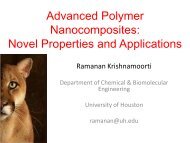Richard E. Smalley Institute for Nanoscale Science and - Center for ...
Richard E. Smalley Institute for Nanoscale Science and - Center for ...
Richard E. Smalley Institute for Nanoscale Science and - Center for ...
You also want an ePaper? Increase the reach of your titles
YUMPU automatically turns print PDFs into web optimized ePapers that Google loves.
George Hirasaki<br />
Walter Chapman<br />
Andrew Barron<br />
George Bennett<br />
32<br />
Unconventional Carbon-Based Energy<br />
Oil S<strong>and</strong>s, Gas Hydrates, Shale <strong>and</strong><br />
Biofuels<br />
Professor George Hirasaki is investigating<br />
effectively separating nanodroplets of oil<br />
from bitumen solids through an Alberta<br />
Collaborative grant. The surfactant <strong>and</strong><br />
polymer-based micelles Hirasaki’s lab<br />
investigates <strong>for</strong> enhanced oil recovery<br />
are also applicable in enhanced oil s<strong>and</strong>s<br />
recovery. The surfactants wet the bitumen<br />
solids <strong>and</strong> aggregate the oil nanodroplets<br />
<strong>for</strong> harvesting.<br />
Professor Walter Chapman models the<br />
decomposition <strong>and</strong> <strong>for</strong>mation of gas<br />
hydrates, self-assembled nanostructure<br />
cages that encapsulate gas molecules.<br />
The amount of carbon in gas hydrates<br />
is estimated to be more than twice the<br />
amount of carbon in all other fossil fuel<br />
deposits. Chapman’s group combines<br />
nuclear magnetic resonance <strong>and</strong> molecular<br />
simulation with phase equilibria <strong>and</strong><br />
kinetic studies to provide needed thermodynamic,<br />
transport <strong>and</strong> kinetic data <strong>for</strong><br />
hydrate decomposition.<br />
Professor Barron has developed a series of<br />
nano-enhanced proppants. The proppant’s<br />
decreased weight <strong>and</strong> higher strength<br />
increase the effective fracture length, enhance<br />
control over created fracture geometry<br />
<strong>and</strong> reduce the environmental impact<br />
of hydraulic fracturing. Modeling suggests<br />
the nano-enhanced proppants could increase<br />
initial production by 50 percent <strong>and</strong><br />
shallow production decline by 15 percent.<br />
The hollow silica proppant lends itself to<br />
incorporation of sensor technologies <strong>for</strong><br />
smart proppants, currently under development<br />
in Barron’s laboratory.<br />
Professor George Bennett’s laboratory focuses<br />
on genetic engineering of metabolic<br />
pathways of microbes <strong>for</strong> production of<br />
biofuels <strong>and</strong> chemicals. Their metabolic<br />
engineering yields a “cellular refinery” approach<br />
of producing multiple compatible<br />
products during a process. Bennett is investigating<br />
genetic alterations in metabolic<br />
pathways of bacteria to produce butanol<br />
<strong>and</strong> ethanol.






